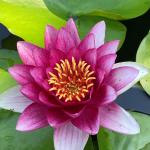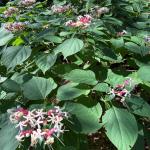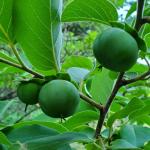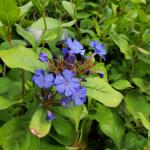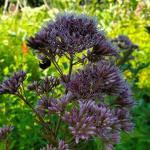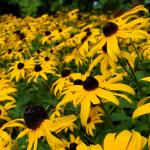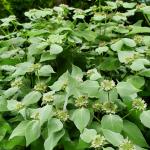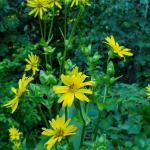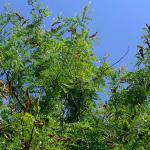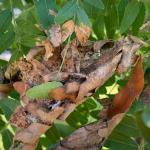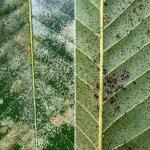UMass Extension's Landscape Message is an educational newsletter intended to inform and guide Massachusetts Green Industry professionals in the management of our collective landscape. Detailed reports from scouts and Extension specialists on growing conditions, pest activity, and cultural practices for the management of woody ornamentals, trees, and turf are regular features. The following issue has been updated to provide timely management information and the latest regional news and environmental data.
Registration has begun for our UMass Extension GREEN SCHOOL!
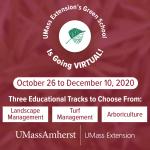 Green School is going VIRTUAL for 2020! Classes will be Oct. 26 - Dec. 10.
Green School is going VIRTUAL for 2020! Classes will be Oct. 26 - Dec. 10.
This comprehensive 12-day certificate short course for Green Industry professionals is taught by UMass Extension Specialists, University of Massachusetts faculty, and guest presenters.
Three Specialty Tracks Are Offered
* Landscape Management
* Turf Management
* Arboriculture - specifically geared toward professional arborists
Find the full schedule and registration info at http://ag.umass.edu/greenschool
The UMass Plant Diagnostic Lab and the Soil & Plant Nutrient Testing Lab are open and taking samples (mail-in only please, walk-in samples cannot be accepted). Allow additional turnaround time as mail delivery and staffing have been altered due to the pandemic.
- Plant disease, insect pest and invasive plant/weed samples: go to https://ag.umass.edu/services/plant-diagnostics-laboratory for more details.
- Routine soil analysis and particle size analysis ONLY (no other types of analyses available at this time): go to https://ag.umass.edu/services/soil-plant-nutrient-testing-laboratory.
Pesticide License Exams - The MA Dept. of Agricultural Resources (MDAR) is holding exams for new exam applicants. Space is still limited; to register, go to: https://www.mass.gov/pesticide-examination-and-licensing.
To read individual sections of the message, click on the section headings below to expand the content:
Scouting Information by Region
Environmental Data
The following data was collected on or about August 5, 2020. Total accumulated growing degree days (GDD) represent the heating units above a 50° F baseline temperature collected via our instruments for the 2020 calendar year. This information is intended for use as a guide for monitoring the developmental stages of pests in your location and planning management strategies accordingly.
|
MA Region/Location |
GDD |
Soil Temp |
Precipitation
|
Time/Date of Readings |
||
|
2-Week Gain |
2020 Total |
Sun |
Shade |
|||
|
CAPE |
400 |
1586.5 |
79 |
74 |
0.17 |
12:00 PM 8/5 |
|
SOUTHEAST |
420 |
1741.5 |
95 |
75 |
0.80 |
3:30 PM 8/5 |
|
NORTH SHORE |
389.5 |
1694 |
72 |
69 |
1.11 |
10:30 AM 8/5 |
|
EAST |
438 |
1854 |
79 |
75 |
0.59 |
5:00 PM 8/5 |
|
METRO |
370 |
1726 |
71 |
69 |
2.77 |
6:00 AM 8/5 |
|
CENTRAL |
381.5 |
1744.5 |
67 |
66 |
1.63 |
7:30 AM 8/5 |
|
PIONEER VALLEY |
362 |
1743 |
73 |
69 |
1.48 |
11:00 AM 8/5 |
|
BERKSHIRES |
329.5 |
1581 |
72 |
68 |
3.41 |
8:30 AM 8/5 |
|
AVERAGE |
386 |
1709 |
76 |
71 |
1.50 |
_ |
|
n/a = information not available |
||||||
As of 8/4, this map of MA shows all of our state continues to experience "Moderate Drought" (D1) or "Abnormally Dry" (D0) conditions: https://droughtmonitor.unl.edu/CurrentMap/StateDroughtMonitor.aspx?MA
To track water use restrictions/bans by town, regularly check the MassDEP map: https://www.mass.gov/doc/water-use-restrictions-map/download
Phenology
| Indicator Plants - Stages of Flowering (BEGIN, BEGIN/FULL, FULL, FULL/END, END) | ||||||||
|---|---|---|---|---|---|---|---|---|
|
PLANT |
CAPE |
SE |
NS |
EAST |
METRO |
CENT |
PV |
BERK |
|
Clethra alnifolia (summersweet Clethra) |
Begin |
Begin/Full |
Begin/Full |
Begin/Full |
Begin |
Begin/Full |
Full |
Begin/Full |
|
Styphnolobium japonicum (L.) Schott (Japanese Pagoda tree) |
* |
* |
Full |
* |
* |
* |
Full |
* |
|
Lythrum salicaria (loosestrife) |
Full |
Full |
Full |
Full |
Full |
Full |
Full |
Full |
|
Buddleia davidii (butterfly bush) |
Full |
Full/End |
Full |
Full |
Full |
* |
Full |
Full |
|
Hydrangea paniculata (panicle Hydrangea) |
Full |
Full/End |
Full |
Full |
Full |
Full |
Full |
Full |
|
Hibiscus syriacus (rose-of-Sharon) |
Begin/Full |
Full/End |
Full |
Full |
Full |
Full |
Full |
Full |
| * = no activity to report/information not available | ||||||||
Regional Notes
Cape Cod Region (Barnstable)
General Conditions: The average temperature for the period from July 22 thru August 5 was 78˚F with a high of 96˚F on July 28 and a low of 63˚F on August 1. The period included three days over 90, July 26-28, a rare occurrence for the Cape. Overall, the past two weeks have been dominated by days in the 80s and night in the 70s – it has been a very hot stretch of summer weather. The period also included fairly windy conditions, variable relative humidity, and only 0.17 inches of precipitation. This lack of rain, the hot weather and windy conditions are adding to the already moisture stressed vegetation. Topsoil and subsoil moisture conditions are dry. The US drought monitor listed the area as in Moderate Drought as of August 6. https://droughtmonitor.unl.edu/CurrentMap/StateDroughtMonitor.aspx?MA The number of water districts with either voluntary or mandatory water restrictions is increasing. https://www.mass.gov/info-details/outdoor-water-use-restrictions-for-cities-towns-and-golf-courses#current-city-and-town-water-restrictions- Unfortunately, the area did not receive any significant precipitation from Isaias as it quickly blew by, leaving some small twigs to pick up but little significant damage.
Pests/Problems: Honeydew from lecanium scale has resumed as the immature insects have migrated to the leaves to feed. In areas with high populations, the insects, even though they are small (<1mm), are readily seen as white flecks on the surface of leaves. Nantucket pine tip moth damage is prevalent on pitch pine throughout much of the Cape. The hot dry conditions have encouraged spider mites that can be seen damaging a number of both herbaceous and woody ornamentals. Other insects or insect damage seen during the period includes lacebugs on azalea, Andromeda, and sycamore, Japanese, Oriental, and a great number of Asiatic beetle adults on ornamentals, bark beetle damage to eastern red cedar, turpentine beetle damage to pitch pine, white pine weevil damage to white pine, daylily leaf miner on daylily columbine leaf miner on columbine, chilli thrips on Hydrangea, earwig damage on Buddleia and H. paniculata, Hibiscus sawfly on hardy Hibiscus, and chinch bug damage to turf. Disease symptoms or signs observed during the period include apple scab and cedar apple rust on crabapple, leaf spot on river birch, powdery mildew on flowering dogwood, anthracnose on flowering dogwood, Septoria leaf spot on red twig dogwood, anthracnose on red maple, Cercospora leaf spot on bigleaf and oak leaf Hydrangea, Iris leaf spot on bearded Iris, Macrophoma leaf spot on boxwood, Volutella blight on boxwood, boxwood blight on boxwood, and powdery mildew on the usual Monarda, lilac, Phlox, rose. Purslane, prostrate spurge, and crabgrass are all thriving under the dry soil conditions. Also problematic are deerflies, greenhead flies, mosquitoes, ticks, yellow jackets and RABBITS!
Southeast Region (Dighton)
General Conditions: Midsummer was somewhat rudely ushered in by tropical storm Isaias. Thankfully we received some much-needed downpours to break a dismal drought. High humidity and heat were the rule previously. I saw air temperatures of 100˚F in the West Bridgewater area midafternoon on 7/29. Monarchs, and both black and yellow swallowtail butterflies grace the flower banks. Mud dauber wasps with violet wings, carpenter bees, and golden sand digger wasps are active. When not frequenting flowers, the mud daubers prey on spiders while the sand diggers attack Orthoptera (grasshoppers, crickets). Hummingbirds are busy squabbling over territory with amazing feats of flight. Fledgling sparrows follow their parents begging. I've noticed the following plants in flower: Daucus carota (Queen Anne's lace), Tanacetum vulgare (tansy), Eupatorium purpureum (Joe-Pye-weed), Phlox paniculata (garden Phlox), Asclepias incarnata (swamp milkweed), Hibiscus syriacus (rose of Sharon), Rosa 'Knockout', Solidago juncea (early goldenrod), Monarda didyma (scarlet bee-balm), Hydrangea quercifolia (oakleaf Hydrangea), H. paniculata (panicle Hydrangea), Salvia spp. (garden salvia), Salvia yangii (Russian sage), Rudbeckia hirta (black-eyed-Susan), Coreopsis lanceolata (tickseed), Lysimachia clethroides (gooseneck loosestrife), Lythrum salica (purple loosestrife), Ambrosia artemisiifolia (annual ragweed), Artemisia vulgaris (mugwort), Liatris spicata (blazing star), Campsis radicans (trumpet vine), Clethra alnifolia (summersweet) , Centaurea stoebe (spotted knapweed) and Buddelia davidii (butterfly bush).
Pests/Problems: Mosquitoes make the top rank for problems. There is a reported case of EEE in Middleboro of a 19-year-old male. That probably meets the average demographic for landscape workers in the field. It's hard to stay covered up and easier to work in shaded areas where mosquitoes are present. The risk will only increase from here on and recent rains will provide additional breeding sites for some species. Among all of the other dangers in our profession, heat stroke is an issue recently. I've seen experienced hands head out without adequate water. Check your co-workers regularly. Unirrigated turf has taken a beating and is burnt out in many areas. All but well established and well sited plantings are showing stress, even with irrigation. Other problems are grey mold on peach, leafhoppers on cannabis, and black and red seedbug on swamp milkweed. Nutsedge, spotted speedwell, crabgrass, yellow wood sorrel, purslane and yellow nutsedge are all evident on dormant turf.
North Shore (Beverly)
General Conditions: Hot, dry and humid conditions persisted during this reporting period except for a few quick storms that brought some rain showers. Most of the rain was received in the last week of July. Approximately 1.11 inches of rain was recorded at Long Hill during this period. Temperatures of 90℉ and above were recorded for four of the 14 days. The average daily temperature for this period was 78℉ with the maximum temperature of 94℉ recorded on July 27 and the minimum temperature of 63℉ recorded on August 1. Woody plants seen in bloom include: Japanese pagoda tree (Sophora japonica), bottlebrush buckeye (Aesculus parviflora), sourwood (Oxydendrum arboreum), silk tree or mimosa (Albizia julibrissin), Chinese chaste tree (Vitex negundo), golden rain tree (Koelreuteria paniculata), smooth leaf Hydrangea (Hydrangea arborescens), butterfly bush (Buddleia davidii), rose-of-Sharon (Hibiscus syriacus) and harlequin glorybower (Clerodendrum trichotomum). Herbaceous plants seen in bloom include: milkweed (Asclepias spp), globe thistle (Echinops ritro), garden Phlox (Phlox paniculata), Hostas (Hosta spp.), Sedums (Sedum spp.), Clematis vines (Clematis paniculata), water lily (Nymphaea odorata) and an assortment of annuals.
Pests/Problems: Cottony scale on silverbell and bark scale on azalea continued to be observed. Also observed were cotton scales on Magnolia. Groundhogs and slugs were seen causing damage in the vegetable garden. Some deer damage was noted on Hostas. Powdery mildew continued to be problem on susceptible lilac varieties. Iron deficiency symptoms (interveinal chlorosis) were observed on azalea and blueberries. Watch for poison ivy as you walk or work in the woods. Remember also that ticks and mosquitoes are still very active. Protect yourself with insect repellent.
East Region (Boston)
General Conditions: The heat continues as we experienced temperatures over 90°F on 10 of the last 14 days, reaching 101°F on July 17. We experienced two heat waves, the first from July 25 to 30 and the second from August 1 to 3. Despite the hot daytime temperatures, evening temperatures have been more bearable. High temperatures ranged from 85°F to 101°F, averaging 93.8°F! Low temperatures ranged from 63°F to 75°F, averaging 68.6°F. Tropical Storm Isaias arrived on August 4 bringing strong winds with gusts reaching 30mph but minimal rain as only 0.15 inches were recorded. Over the last two weeks, spread across 4 different occasions, we have received only 0.59 total inches of rain. We have gained 438 GDDs bringing the total to 1854 so far this year. Despite the lack of rain and dry conditions, the landscape continues to flourish.
Pests/Problems: The lack of substantial rainfall coupled with the hot temperatures in the 90s is of concern. Soils are so dry that supplemental irrigation is necessary at this time, so gardens and managed landscapes should be checked daily. Premature leaf drop continues for many trees including birch, Norway maple and redbud that are suffering from water stress. Clean up is necessary following Tropical Storm Isaias, as the landscape is scattered with branches, leaves and debris.
Metro West (Acton)
General Conditions: The hot and humid weather continued into this reporting period. This area experienced its third 6-day heat wave of the summer beginning on July 25th and including and ending on the 30th. Overall, there have been 23 days this summer with temperatures recorded in the 90s, 16 of which occurred in July and the other 7 in June. For July, the historical monthly average precipitation is 4.07” and a total of 3.79” was recorded for this area. For August, the historical monthly average precipitation is 3.72” and as of the 4th, a total of .46” has been recorded. Observed in some stage of bloom in the past couple of weeks were the following woody plants: Buddleia spp. (butterfly-bush), Clethra alnifolia (summersweet), Hibiscus syriacus (rose-of-Sharon), H. paniculata (panicle Hydrangea, and its many cultivars including 'Tardiva'), Potentilla fruiticosa (Potentilla), Rhus typhina (staghorn sumac), Rosa 'Knockout' (knockout family of roses), and R. spp. (rose). Woody vines observed in bloom were: Campsis radicans (trumpet vine) and Clematis spp. (Clematis). Contributing even more color and interest to the landscape are some flowering herbaceous plants including: Achillea millefolium (yarrow), Alcea rosea (Hollyhocks), Asclepias syriaca (common milkweed), A. tuberosa (butterfly weed), Astilbe spp. (false spirea), Boltonia asteroides (Bolton’s aster), Campanula persicifolia (peach-leaved bellflower), C. takesimana ‘Elizabeth’ (bell flower), Cichorium intybus (chicory), Coreopsis spp. (tickseed), C. verticillata (threadleaf Coreopsis), Daucus carota (Queen Anne's lace), Echinacea purpurea (coneflower, and its many cultivars), Eutrochium purpureum (Joe Pye weed), Hemerocallis fulva (orange daylily), H. 'Stella D'Oro' (daylily), H. spp. (daylily), Hosta spp. (plantain lily), Kirengeshoma palmata (yellow wax bells), Leucanthemum spp. (shasta daisy), Liatris spicata (spike gayfeather), Lilium spp. (lily), Lychnis coronaria (rose campion), Lysimachia clethroides (gooseneck loosestrife), Lythrum salicaria (purple loosestrife), Monarda didyma (scarlet bee-balm), Patrinia gibbosa (Patrinia), Perovskia atriplicifolia (Russian sage), Phlox carolina (Carolina Phlox), P. paniculata (garden Phlox), Platycodon grandiflorus (balloon flower), Rudbeckia fulgida var. sullivantii 'Goldsturm' (black-eyed Susan), Senna marilandica (Maryland wild Senna), Solidago spp. (goldenrod), Thymus praecox (thyme), Tradescantia sp. (spiderwort), Veronica spp. (speedwell), and Veronicastrum virginicum (culver’s root).
Pests/Problems: On Tuesday, August 4th,, tropical storm, Isaias threatened this area with heavy rain and strong winds. Because it was moving so fast, it left in its wake scattered power outages, limited downed trees and limbs and only 0.22” of rain. Despite the frequent rains, the U.S. Drought Monitor continues to declare this area in a moderate drought.
Central Region (Boylston)
General Conditions: We continued the mid-summer pattern of hot, muggy, and dry weather conditions this reporting period. Although we measured more than 3” of precipitation for the month of July, most of the rainfall came in the form of quick bursts of thundershowers and brief downpours. Much of that precipitation ran off the dry soils, leaving very little to replenish garden soils. Drought stress continues to be a major issue, leading gardeners to provide supplemental irrigation to even established trees and shrubs. Fortunately, we have a lot in bloom at the moment. Observed during this reporting period were many flowering native plants, including Clethra alnifolia (summersweet), Eupatorium perfoliatum (boneset), Eutrochium maculatum (spotted Joe-Pye weed), Hibiscus moscheutos (swamp rose mallow), Lobelia cardinalis (cardinal flower), L. siphilitica (great blue Lobelia), Pycnanthemum muticum (broad-leaved mountain mint), Rudbeckia laciniata (green coneflower), Scutellaria incana (skullcap), Senna hebecarpa (American/wild senna), Silphium perfoliatum (cup plant), Spiraea tomentosa (steeplebush), and Vernonia noveboracensis (New York ironweed).
Pests/Problems: As previously mentioned, drought continues to be the major landscape problem this summer. Early leaf drop was observed this period, primarily on species of birch. It has been a remarkably quiet year for insects and diseases, although some notable pests have been active lately, including Asiatic beetles, Viburnum leaf beetle, and Hibiscus sawfly. Also notable this period was oak twig pruner beetle (see disease report below), which girdles twigs of various oak species, causing them to drop to the ground in light breezes.
Pioneer Valley Region (Easthampton)
General Conditions: Late summer is officially here in the Pioneer Valley as we settle into August. July closed out much the same as it began; very hot. According to the NRCC, July was one of the hottest months ever recorded at many northeastern weather stations. On 7/27, the heat index peaked >100°F in the valley, making it one of the hottest days of the year. The area experienced several fast-moving thunderstorms over this reporting period (7/22, 7/23, 7/29, 7/30, 8/2) resulting in dramatically varying levels of precipitation. On Sunday, 8/2 an EF0 tornado was confirmed in southeastern Berkshire (Sandisfield) and western Hampden (Tolland) Counties. Two days later, on 8/4, tropical storm Isaias barreled north through the region bringing ferocious wind gusts, but the storm did not deliver the soaking rainfall we were anticipating. The original forecast anticipated up to and over 2″ of accumulation, but <0.4″ was recorded at the Easthampton gauge. Very disappointing. The late afternoon winds resulted in stem breakage and uprooting of many trees. Large and small limbs were scattered everywhere throughout the landscape and thousands lost power in the tri-counties. As the storm cleared out, the long-term forecast calls for cooler temperatures in the mid-80s and some cooler nights, with temperatures expected in the upper 50s to lower 60s. If you’ve had your windows open at night, the cicadas and crickets are in full chorus right now, a welcome late summer sound.
Pests/Problems: Despite the below-average precipitation this summer, many landscape trees and shrubs appear very healthy right now. Crabapples and apples, however, are really thinning out due to apple scab (Venturia inaequalis). Interestingly, damage from Marsonnina blight (Marssonina coronaria) on crabapples is minimal right now in Hampshire County, as opposed to last season. Hard pines (two- and three-needle) may be beginning to show symptoms of Cyclaneusma and Lophodermium needlecast. Both of these fungi sporulate and spread readily in late summer to early fall. Contact fungicides on current season’s needles can help to reduce new infections. Mimosa webworm (Homadaula anisocentra) damage on honeylocust is very abundant in the Amherst area (see photos). Much of the feeding and nest making took place in late June through mid-July. Dogwood powdery mildew (Erysiphe pulchra) has been common this year and many trees on the UMass campus have chlorotic spots or appear off-color as a result of infections. Horse chestnuts look typically ratty, due to Guignardia leaf blotch. Wood-rotting fungi continue to appear so be mindful to identify these pathogens when they appear. Numerous mycorrhizal fungi are producing mushrooms at this time, especially at wet and shaded sites. Lace bug and spider mite injury on oaks is very conspicuous at this time (see photo below for lace bug damage). The tobacco budworm (Heliothis virescens) was encountered feeding on flowers of Nicotiana, Geranium and Petunia. Wasps of every variety are particularly abundant this year, perhaps due to better overwintering success from the mild winter. Rodent feeding and deer browsing continue as well.
Berkshire Region (Great Barrington)
General Conditions: For much of the past two weeks, weather conditions were typical of mid-summer, that is, hazy, hot and humid. Day time high temperatures, as recorded at Pittsfield Airport, ranged from a high of 90˚F on July 27 to a low of 80˚F just a day later. Night time lows ranged from 69˚F on August 3 to 57˚F on July 29. Up until Tuesday, August 4, rainfall for the year-to-date was just over 6 inches shy of normal. Needless to say, but I’ll say it: it has been a dry summer. The big news over the two-week monitoring period was the storm on Tuesday, August 4th. Wind gusts of 50 mph or higher, accompanied by heavy downpours (1.55 inches measured at this site in West Stockbridge) caused considerable damage throughout the County. The storm brought down huge numbers of trees, causing considerable damage to homes, vehicles, roadways, landscapes, and even some personal injuries. Power outages were common and some areas are still without power as of this date (8/6).
Pests/Problems: The difficulty of getting around due to the storm damage has limited some of the usual scouting routine. Nevertheless, plant pests observed include Oriental beetle, Asiatic garden beetle, imported willow leaf beetle (adults), aphids, and spider mites. Despite the overall dry conditions, slugs, including some very large individuals, are feeding voraciously on herbaceous perennials, especially on well-irrigated or otherwise damp sites. Wasps, mosquitoes, deer flies, eye gnats, and deer ticks continue to pose a problem for the human element in the landscape. Plant diseases observed include apple scab on crabapples, black spot on roses, an assortment of leaf spots on deciduous trees, powdery mildew on phlox, lilacs and other susceptible herbaceous perennials, and mosaic virus on rose foliage. Sap bleeding cankers were observed on a smoke bush (Cotinus coggygria) as was verticillium wilt on sugar maple. Browsing activity by deer, woodchucks, rabbits, and chipmunks remains high, perhaps due to the succulent nature of the herbaceous perennials which are targeted most often by these critters.
Regional Scouting Credits
- CAPE COD REGION - Russell Norton, Horticulture and Agriculture Educator with Cape Cod Cooperative Extension, reporting from Barnstable.
- SOUTHEAST REGION - Brian McMahon, Arborist, reporting from the Dighton area.
- NORTH SHORE REGION - Geoffrey Njue, Green Industry Specialist, UMass Extension, reporting from the Long Hill Reservation, Beverly.
- EAST REGION - Kit Ganshaw & Sue Pfeiffer, Horticulturists reporting from the Boston area.
- METRO WEST REGION – Julie Coop, Forester, Massachusetts Department of Conservation & Recreation, reporting from Acton.
- CENTRAL REGION - Mark Richardson, Director of Horticulture reporting from Tower Hill Botanic Garden, Boylston.
- PIONEER VALLEY REGION - Nick Brazee, Plant Pathologist, UMass Extension Plant Diagnostic Lab, temporarily reporting from Easthampton.
- BERKSHIRE REGION - Ron Kujawski, Horticultural Consultant, reporting from Great Barrington.
Woody Ornamentals
Diseases
Given that we just experienced an extremely hot July, it’s another opportunity to marvel at the ability of plants to withstand climatic extremes in the landscape. For plants growing in exposed, full sun settings, the heat load on the foliage is extremely high. However, leaves absorb only about 50% of all solar energy (Taiz et al. 2018) as heat is dissipated through three separate processes: convective, latent and radiative heat loss. Convective heat loss occurs when the leaf temperature is higher than the circulating air and heat is transferred to the atmosphere. The “quaking” that trembling aspen (Populus tremuloides) leaves demonstrate is an adaptation to improve convective heat loss. Latent heat loss occurs when water evaporates from the leaf, transferring heat energy and lowering the leaf temperature. This vital process, known as transpiration (similar to perspiration in humans), results in the majority of water usage during the heat of the summer. Radiative heat loss results in only minor cooling and is not as important as convective and latent heat loss. Regardless of the type of cooling that occurs, anyone who has ever sat in the dense shade of a large tree knows well the enormous amount of solar energy that’s absorbed.
When trees and shrubs are exposed to heat and drought, the physiological response to the two stresses can be opposing and lead to further damage. When plants begin to suffer heat stress, they attempt to cool down by increasing rates of transpiration. Yet, when they are also suffering from drought stress, the natural response is to close stomata and preserve water, lowering transpiration rates. A reduction in transpiration can then result in increased leaf temperatures, creating further heat stress and the development of scorch symptoms (Taiz et al. 2018). This is why it’s so important to keep plants well-watered during extended dry periods during the hottest weeks of mid-summer. Even when growth is mostly to fully complete for the season, significant amounts of water are required for natural cooling.
(Taiz, L., Zeiger, E., Møller, I.M. and Murphy, A. 2018. Plant Physiology and Development, 6th edition. Sinaur Associates, Inc., Sunderland, MA, USA)
Recent pests and pathogens of interest seen in the UMass Extension Plant Diagnostic Lab https://ag.umass.edu/services/plant-diagnostics-laboratory:
Stem cankering and dieback of Japanese holly (Ilex crenata 'Green Luster'), inkberry (Ilex glabra 'Shamrock') and American holly (Ilex opaca). Seven young Japanese hollies were transplanted to a full sun site with drip irrigation in late spring. Since early to late June, 4/7 have developed symptoms of shoot and leaf blight and Botryosphaeria was present on the submitted shoots. Eight young inkberries were also transplanted this season into a shaded setting with drip irrigation. In late June, 4/8 developed symptoms of decline (blackening stems, browning leaves and premature leaf shedding). Both Botryosphaeria and Phomopsis were present on the submitted tissue. The American holly is approximately 20-years-old and has been present at the site for 10 years. Site conditions include full sun with good soil drainage and some irrigation from lawn sprinklers. This season, shoot dieback in the upper canopy was observed and submitted shoots had visible lesions and blackened leaves. Phomopsis was present on both the stems and foliage after incubation.
Phomopsis stem cankering on Japanese maple (Acer palmatum). Tree is roughly 30-years-old and resides in a raised corner bed ten feet from a gravel patio with half-shade from surrounding trees. On scattered branches in the canopy, leaves became brown and shriveled in early July and symptoms were not observed in previous years. There was no evidence of Verticillium wilt from the submitted sample. Phomopsis is a common pathogen on Japanese maples in the region.
Needle and shoot blight in the upper canopy of Leyland cypress (Cupressus ×leylandii) caused by Pestalotiopsis. Six trees were planted as a privacy screen in two cohorts, one planted 20 years ago and another ten years ago. Since 2018, the top of one of the younger trees has consistently become brown and declined. Once the dead terminal is pruned out, new dieback develops the following year. Trees are watered by hand as needed with increasing shade developing on the trees. Pestalotiopsis was abundant on the submitted sample and no other pests or pathogens could be found.
Rhododendron whitefly (Dialeurodes chittendeni) infestation on Wilson Rhododendron (Rhododendron × laetevirens). Shrub is approximately 25-years-old and is growing in a lawn setting with partial sun and well-drained soils. Recently, the plant began to uniformly wilt over a very short period of time. Submitted roots were healthy with no symptoms of disease and specific testing for Phytophthora was negative. The foliage was pale green and curled and no stem cankering or foliar blight pathogens could be isolated. The foliage did have a severe whitefly infestation, which likely contributed to the decline but is unlikely to be the sole cause. Whiteflies are related to scales and aphids and like both, use their piercing and sucking mouthparts to extract fluids from infested leaves and stems.
Fire blight of southern crabapple (Malus angustifolia) caused by Erwinia amylovora. Young sapling (~four-years-old) in an arboretum with full sun and overhead watering. In mid-July, the tree developed symptoms of fire blight, which included blackening of terminal shoots, leaves and petioles and a curling of the terminal (Shepard’s crook). No other pests or pathogens were detected.
Decline of Spaeth’s purple beech (Fagus sylvatica 'Spaethiana') caused by Asterosporium (cankering) and Apiognomonia (anthracnose). Tree is 70-years-old and growing in an arboretum with full sun and supplemental irrigation in a mulched bed. In mid- to late June, wilting leaves and branch dieback was observed in 20% of the canopy. The symptoms were apparent last year but were minor in severity. Asterosporium is known to cause stem and branch cankers on beech, and the dark-colored spores create a black, dusty coating on branches with cracked and sloughing bark. This pathogen has been found at the site previously, on European and American beech.
Severe infestation of the spruce spider mite (Oligonychus ununguis) on eastern hemlock (Tsuga canadensis). Old and established hedge of hemlock, possibly 50-years-old. Submitted needles were heavily infested, with the chlorotic flecking symptom consuming most of the needle surface. Cast skins of old mites were very abundant as were egg cases. While not noted in this case, the use of imidacloprid to control the hemlock woolly adelgid can suppress natural predators of spider mites, leading to major outbreaks.
Birch anthracnose, caused by Marssonina betulae, on river birch (Betula nigra). The tree is 50-years-old and resides in full sun in a mulched bed near a maintained lawn. In early summer, premature leaf shedding was observed. Foliage was yellowing with brown spots throughout. Birch anthracnose can be caused by several different fungi, which cause a range of symptoms. However, premature leaf shedding is a consistent outcome of all infections, regardless of the pathogen.
Black canker of willow (Salix babylonica) caused by Colletotrichum salicis (also known as Glomerella miyabeana). Tree is 60- to 70-years-old and resides in a full sun residential setting near the coast where it’s exposed to extended, cool spring weather with ample fog. The submitted sample had blackened and wilted leaves and blackened shoots. Black canker of willow can be quite destructive on young and mature trees, causing scattered canopy dieback. The pathogen is able to sporulate whenever environmental conditions allow, which is typically mild and wet.
Transplanting injury on white spruce (Picea glauca). Tree is 14' tall and was recently delivered and planted into a residential landscape by a tree farm in mid-July. The homeowners discovered black-colored stains on the main trunk and assumed the tree was diseased. Branch breakage and tear out during the digging, shipment and transplanting process resulted in resin flow and staining of the bark. Some level of physical injury is to be expected when transplanting such a large spruce. No pathogens were found and surprisingly, no needle blight pathogens were detected either, given how ubiquitous they are on landscape spruce. With watering and pruning of dead shoots, the tree will hopefully adapt to the new site.
Oak twig pruner (Anelaphus parallelus) injury on pin oak (Quercus palustris). Tree is 60- to 80-years-old and grows in a full sun landscape setting with well-drained, sandy loam soils. Overall, the tree appears healthy. In recent weeks, terminal shoots have been found scattered around the base of the tree. The cut ends of the shoots are very clean, as if they were manually pruned. The presence of a small, oval-shaped plug in the cut end of the twigs is also an indicator the oak twig pruner is responsible. This common insect pest has a two-year life cycle, so infested trees often exhibit damage in alternating years. Cutting open the base of the pruned twigs revealed the relatively large, white larvae and visible tunneling down the center of the stems.
Report by Nick Brazee, Plant Pathologist, UMass Extension Plant Diagnostic Lab, UMass Amherst.
Insects
Did you miss the live broadcasts of UMass Extension’s Invasive Insect Webinar Series? No problem! View the archived recordings of all seven webinars here:https://ag.umass.edu/landscape/education-events/invasive-insect-webinars
Interesting Insects Reported or Seen Since the Last Landscape Message:
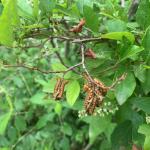
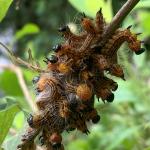
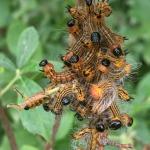
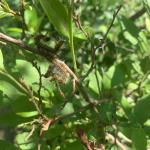
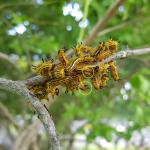 Datana spp. on Blueberry: the caterpillars pictured here were reported on blueberry in Edgartown, MA on 7/30/2020 courtesy of Marc Fournier, Arborist and Horticulturist with the Trustees of Reservations. The species pictured here could be one of two species of Datana caterpillars known to feed on blueberry in the Northeast, either the yellow-necked caterpillar (Datana ministra) or Drexel's datana (Datana drexelii). Both of these insects are native to eastern North America. Some differences important in identifying these caterpillars include:
Datana spp. on Blueberry: the caterpillars pictured here were reported on blueberry in Edgartown, MA on 7/30/2020 courtesy of Marc Fournier, Arborist and Horticulturist with the Trustees of Reservations. The species pictured here could be one of two species of Datana caterpillars known to feed on blueberry in the Northeast, either the yellow-necked caterpillar (Datana ministra) or Drexel's datana (Datana drexelii). Both of these insects are native to eastern North America. Some differences important in identifying these caterpillars include:
- Yellow-necked caterpillar (Datana ministra) - generally black with four yellow stripes down each side and comparatively sparse white setae (hairs); the prothoracic plate behind the head is orange (which can be seen clearly in these photos); but at least 4 other eastern Datana have similar caterpillars (yet only two of which are reported on blueberry). Hosts: apple, oak, birch, blueberry, willow, and other woody shrubs and trees.
- Drexel's datana (Datana drexelii) - similar in general appearance to the yellow-necked caterpillar, but it also sports an "orange rump patch" which is formed by the confluence of the orange stripes over segments A8 and A9. Hosts: most commonly blueberry and other heaths and witch hazel.
The photos from Edgartown do not clearly show the “orange rump patch”, however it would be best to examine some of these caterpillars to be certain of a species ID. For comparison, see the last photo of a cluster of Drexel’s datana seen on 8/21/2018 in Chesterfield, MA. In this photo, the “orange rump patch” is circled on two individuals. If you can’t share your blueberry leaves with these caterpillars, at this time of year they are so large and the fact that they feed in clumps makes it very easy to locate all of them on a shrub and manually remove them.
Are you interested in identifying native caterpillars of New England? A fantastic and easy to use resource is “Caterpillars of Eastern North America” by David L. Wagner (2005).
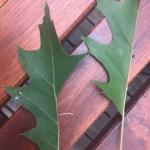 Prominent Moth Caterpillars: Feeding damage similar to what is shown on these oak leaves was recently reported by the University of New Hampshire Cooperative Extension Forestry and Wildlife Program. They report having received “several reports of defoliated branches, dropped leaves, and the sound of frass (caterpillar droppings) falling from tree canopies”. In New Hampshire, the culprit is reportedly the saddled prominent, or Heterocampa guttivitta. The saddled prominent (or maple prominent) is a native moth whose caterpillars feed on apple, beech, birch, blueberry, buckeye, chestnut, dogwood, hazel, hickory, hop hornbeam, maple (especially sugar maple), oak, persimmon, sour gum, sumac, walnut, and many other woody plants. The saddled prominent is known as “irruptive”, meaning that populations sometimes can build to where defoliation of large forest tracks in northern New England and eastern Canada are possible. However, as a native species, the saddled prominent is normally controlled by native birds, mammals, and other insects including predators and parasitoids.
Prominent Moth Caterpillars: Feeding damage similar to what is shown on these oak leaves was recently reported by the University of New Hampshire Cooperative Extension Forestry and Wildlife Program. They report having received “several reports of defoliated branches, dropped leaves, and the sound of frass (caterpillar droppings) falling from tree canopies”. In New Hampshire, the culprit is reportedly the saddled prominent, or Heterocampa guttivitta. The saddled prominent (or maple prominent) is a native moth whose caterpillars feed on apple, beech, birch, blueberry, buckeye, chestnut, dogwood, hazel, hickory, hop hornbeam, maple (especially sugar maple), oak, persimmon, sour gum, sumac, walnut, and many other woody plants. The saddled prominent is known as “irruptive”, meaning that populations sometimes can build to where defoliation of large forest tracks in northern New England and eastern Canada are possible. However, as a native species, the saddled prominent is normally controlled by native birds, mammals, and other insects including predators and parasitoids.
In Massachusetts, the cause of this feeding damage has not yet been confirmed by viewing samples of insects caught in the act, however some photographs of prominent moth-like caterpillars were also provided with images of this feeding in Ashburnham, MA. While the photos were clear enough to determine that the culprit in Massachusetts is likely another prominent moth, it is not certain if the activity can be blamed on the saddled prominent, or the variable oakleaf caterpillar or Lochmaeus manteo. This is another prominent-type caterpillar in a different, but related genus. The variable oakleaf caterpillar has (as its name would suggest) a coloration and pattern that is highly variable in individuals. These caterpillars are mostly pale lime or blue-green with a back marked with green or with white or brick red saddles. (However, this species is very similar in appearance to the double-lined prominent, Lochmaeus bilineata and may need to be reared to adulthood to distinguish the two.) The variable oakleaf caterpillar feeds on beech, chestnut, and oak (preferred) but has also been reported on basswood, birch, elm, hawthorn, maple, walnut, and other trees (yet some of these records may be referring to the closely-resembled double-lined prominent).
So, while a definitive identification of the culprit in this case has not yet been made, it would appear that native prominent moth caterpillars are having a good year in some areas of Massachusetts in 2020 as well as New Hampshire, and perhaps other parts of New England!
Insects and Other Arthropods of Public Health Concern:
- Mosquitoes: On July 3, 2020 the Massachusetts Department of Public Health announced that the eastern equine encephalitis (EEE) virus had been detected in mosquitoes in Massachusetts for the first time this year:https://www.mass.gov/news/state-public-health-officials-announce-seasons-first-eee-positive-mosquito-sample-0 . For more information about the first 2020 EEE detection and ways to protect yourself, visit the link above.
For current information, including searchable risk maps for both EEE and WNV in Massachusetts, visit:https://www.mass.gov/info-details/massachusetts-arbovirus-update
According to the Massachusetts Bureau of Infectious Disease and Laboratory Science and the Department of Public Health, there are at least 51 different species of mosquito found in Massachusetts. Mosquitoes belong to the Order Diptera (true flies) and the Family Culicidae (mosquitoes). As such, they undergo complete metamorphosis and possess four major life stages: egg, larva, pupa, and adult. Adult mosquitoes are the only stage that flies and many female mosquitoes only live for 2 weeks (although the life cycle and timing will depend upon the species). Only female mosquitoes bite to take a blood meal, and this is so they can make eggs. Mosquitoes need water to lay their eggs in, so they are often found in wet or damp locations and around plants. Different species prefer different habitats. It is possible to be bitten by a mosquito at any time of the day, and again timing depends upon the species. Many are particularly active from just before dusk, through the night, and until dawn. Mosquito bites are not only itchy and annoying, but they can be associated with greater health risks. Certain mosquitoes vector pathogens that cause diseases such as West Nile virus (WNV) and eastern equine encephalitis (EEE).
For more information about mosquitoes in Massachusetts, visit: https://www.mass.gov/service-details/mosquitoes-in-massachusetts
There are ways to protect yourself against mosquitoes, including wearing long-sleeved shirts and long pants, keeping mosquitoes outside by using tight-fitting window and door screens, and using insect repellents as directed. Products containing the active ingredients DEET, permethrin, IR3535, picaridin, and oil of lemon eucalyptus provide protection against mosquitoes.
For more information about mosquito repellents, visit: https://www.mass.gov/service-details/mosquito-repellents and https://www.cdc.gov/features/stopmosquitoes .
- Deer Tick/Blacklegged Tick: Check out the archived FREE TickTalk with TickReport webinars available here:https://ag.umass.edu/landscape/education-events/ticktalk-with-tickreport-webinars . Previous webinars including information about deer ticks and associated diseases, ticks and personal protection, and updates from the Laboratory of Medical Zoology are archived at the link above.
The next live webinar will be held on August 12, 2020: Extinction of Deer Ticks in North America - Speaker: Dr. Stephen Rich, Professor of Microbiology, University of Massachusetts Amherst; Director the Laboratory of Medical Zoology
Dr. Stephen Rich will discuss a recent publication in Nature (June 2020) from the Laboratory of Medical Zoology that provides insight to the evolutionary and ecological origin of the primary Lyme disease vectors in North America. To register for the next TickTalk, visit:https://ag.umass.edu/landscape/education-events/ticktalk-with-tickreport-webinars
Ixodes scapularis nymphs (immatures) are active, and may be encountered at this time, through August. Nymphs will have already taken a blood meal, and therefore can be infected with disease causing pathogens. It is important to protect yourself against ticks and be especially vigilant for tiny, difficult to see nymphs. For images of all deer tick life stages, along with an outline of the diseases they carry, visit: http://www.tickencounter.org/tick_identification/deer_tick .
Anyone working in the yard and garden should be aware that there is the potential to encounter deer ticks. The deer tick or blacklegged tick can transmit Lyme disease, human babesiosis, human anaplasmosis, and other diseases. Preventative activities, such as daily tick checks, wearing appropriate clothing, and permethrin treatments for clothing (according to label instructions) can aid in reducing the risk that a tick will become attached to your body. If a tick cannot attach and feed, it will not transmit disease. For more information about personal protective measures, visit: http://www.tickencounter.org/prevention/protect_yourself .
Have you just removed an attached tick from yourself or a loved one with a pair of tweezers? If so, consider sending the tick to the UMass Laboratory of Medical Zoology to be tested for disease causing pathogens. To submit a tick to be tested, visit: https://www.tickreport.com/ and click on the blue “Order a TickReport” button. Results are typically available within 3 business days, or less. By the time you make an appointment with your physician following the tick attachment, you may have the results back from TickReport to bring to your physician to aid in a conversation about risk.
The UMass Laboratory of Medical Zoology does not give medical advice, nor are the results of their tests diagnostic of human disease. Transmission of a pathogen from the tick to you is dependent upon how long the tick had been feeding, and each pathogen has its own transmission time. TickReport is an excellent measure of exposure risk for the tick (or ticks) that you send in to be tested. Feel free to print out and share your TickReport with your healthcare provider.
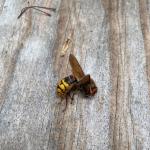
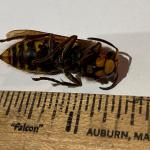 Wasps/Hornets: Many wasps are predators of other arthropods, including pest insects such as certain caterpillars that feed on trees and shrubs. Adult wasps hunt prey and bring it back to their nest where young are being reared, as food for the immature wasps. A common such example are the paper wasps (Polistes spp.) who rear their young on chewed up insects. They may be seen searching plants for caterpillars and other soft-bodied larvae to feed their young. Paper wasps can sting, and will defend their nests, which are open-celled paper nests that are not covered with a papery “envelope”. These open-celled nests may be seen hanging from eaves or other outdoor building structures. Aerial yellow jackets and hornets create large aerial nests that are covered with a papery shell or “envelope”. Common yellow jacket species include those in the genus Vespula. Dolichovespula maculata is commonly known as the baldfaced hornet, although it is not a true hornet. The European hornet (Vespa crabro) is three times the size of a yellow jacket and may be confused for the Asian giant hornet (Vespa mandarinia). The European hornet is known to Massachusetts, but the Asian giant hornet is not. If you are concerned that you have found or photographed an Asian giant hornet, please report it here: https://massnrc.org/pests/report.aspx . A helpful ID tool, although developed for Texas by the USDA, depicts common look-a-like species that we also have in MA that can be confused for the Asian giant hornet and is found here: https://agrilife.org/lubbock/files/2020/05/Asian_Giant_Hornet_Look-alikes_101_Xanthe_Shirley.pdf .
Wasps/Hornets: Many wasps are predators of other arthropods, including pest insects such as certain caterpillars that feed on trees and shrubs. Adult wasps hunt prey and bring it back to their nest where young are being reared, as food for the immature wasps. A common such example are the paper wasps (Polistes spp.) who rear their young on chewed up insects. They may be seen searching plants for caterpillars and other soft-bodied larvae to feed their young. Paper wasps can sting, and will defend their nests, which are open-celled paper nests that are not covered with a papery “envelope”. These open-celled nests may be seen hanging from eaves or other outdoor building structures. Aerial yellow jackets and hornets create large aerial nests that are covered with a papery shell or “envelope”. Common yellow jacket species include those in the genus Vespula. Dolichovespula maculata is commonly known as the baldfaced hornet, although it is not a true hornet. The European hornet (Vespa crabro) is three times the size of a yellow jacket and may be confused for the Asian giant hornet (Vespa mandarinia). The European hornet is known to Massachusetts, but the Asian giant hornet is not. If you are concerned that you have found or photographed an Asian giant hornet, please report it here: https://massnrc.org/pests/report.aspx . A helpful ID tool, although developed for Texas by the USDA, depicts common look-a-like species that we also have in MA that can be confused for the Asian giant hornet and is found here: https://agrilife.org/lubbock/files/2020/05/Asian_Giant_Hornet_Look-alikes_101_Xanthe_Shirley.pdf .
Paper wasps and aerial yellowjackets overwinter as fertilized females (queens) and a single female produces a new nest annually in the late spring. Nests are abandoned at the end of the season. Annually, queens start new nests, laying eggs, and rearing new wasps to assist in colony/nest development. Some people are allergic to stinging insects, so care should be taken around wasp/hornet nests. Unlike the European honeybee (Apis mellifera), wasps and hornets do not have barbed stingers, and therefore can sting repeatedly when defending their nests. It is best to avoid their nests, and if that cannot be done and assistance is needed to remove them, consult a professional.
Woody ornamental insect and non-insect arthropod pests to consider, a selected few:
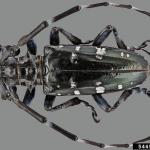
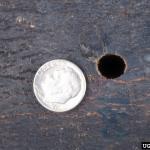
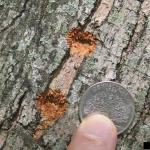 Asian Longhorned Beetle: (Anoplophora glabripennis, ALB) is a serious invasive insect that was first detected in Massachusetts in August of 2008. The USDA has declared August as “tree check month” because this is the peak time of the year to spot ALB adults emerging from trees. For more information about tree check month, visit: https://www.aphis.usda.gov/aphis/newsroom/news/sa_by_date/sa-2020/alb-tree-check-month and https://www.aphis.usda.gov/aphis/resources/pests-diseases/asian-longhorned-beetle/resources/alb-august-tree-check-month
Asian Longhorned Beetle: (Anoplophora glabripennis, ALB) is a serious invasive insect that was first detected in Massachusetts in August of 2008. The USDA has declared August as “tree check month” because this is the peak time of the year to spot ALB adults emerging from trees. For more information about tree check month, visit: https://www.aphis.usda.gov/aphis/newsroom/news/sa_by_date/sa-2020/alb-tree-check-month and https://www.aphis.usda.gov/aphis/resources/pests-diseases/asian-longhorned-beetle/resources/alb-august-tree-check-month
ALB was detected for the first time in South Carolina in 2020. Asian longhorned beetle eradication programs currently exist in Massachusetts, New York, and Ohio. A homeowner is responsible for finding, reporting, and making officials aware of the infestation in South Carolina. Great job!
The U.S. Department of Agriculture’s (USDA) Animal and Plant Health Inspection Service (APHIS) and the Clemson University’s Department of Plant Industry (DPI) are inspecting trees in Hollywood, South Carolina following the detection and identification of the Asian longhorned beetle (ALB).
On May 29, a homeowner in Hollywood, South Carolina contacted DPI to report they found a dead beetle on their property and suspected it was ALB. A DPI employee collected the insect the same day and conducted a preliminary survey of the trees on the property. Clemson’s Plant and Pest Diagnostic Clinic provided an initial identification of ALB, and on June 4, APHIS’ National Identification Services confirmed the insect. On June 11, APHIS and DPI inspectors confirmed that one tree on the property is infested, and a second infested tree was found on an adjacent property. For more information, visit: https://www.aphis.usda.gov/aphis/newsroom/stakeholder-info/sa_by_date/sa-2020/sa-06/alb-sc .
This is a good reminder for us to remain vigilant, and report any suspicious beetles or damage to trees, especially maples. Asian longhorned beetle infests 12 genera of trees, however maples are preferred hosts.
Look for signs of an ALB infestation which include perfectly round exit holes (about the size of a dime), shallow oval or round scars in the bark where a female has chewed an egg site, or sawdust-like frass (excrement) on the ground nearby host trees or caught in between branches. Be advised that other, native insects may create perfectly round exit holes or sawdust-like frass, which can be confused with signs of ALB activity.
The regulated area for Asian longhorned beetle is 110 miles2 encompassing Worcester, Shrewsbury, Boylston, West Boylston, and parts of Holden and Auburn. If you believe you have seen damage caused by this insect, such as exit holes or egg sites, on susceptible host trees like maple, please call the Asian Longhorned Beetle Eradication Program office in Worcester, MA at 508-852-8090 or toll free at 1-866-702-9938.
To report an Asian longhorned beetle find online or compare it to common insect look-alikes, visit: http://massnrc.org/pests/albreport.aspx or https://www.aphis.usda.gov/pests-diseases/alb/report .
More information can be found in the “Trouble Maker of the Month” section of July’s edition of Hort Notes:https://ag.umass.edu/landscape/newsletters/hort-notes/hort-notes-2020-vol-315
- Asiatic Garden Beetle: Maladera castanea adults are active and are typically most abundant in July and August. These rusty-red colored beetles are bullet-shaped and active at night. They are often attracted to porch lights. They feed on a number of ornamental plants, defoliating leaves by giving the edges a ragged appearance and also feeding on blossoms. Butterfly bush, rose, dahlia, aster, and chrysanthemum can be favored hosts.
- Azalea Sawflies: one species of azalea sawfly, Arge clavicornis, is found as an adult in July and lays its eggs in leaf edges in rows. Larvae are present in August and September. Remember, sawfly caterpillars have at least enough abdominal prolegs to spell “sawfly” (so 6 or more prolegs). Bacillus thuringiensis Kurstaki does not manage sawflies.
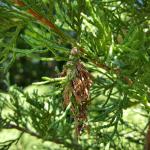
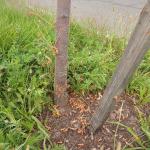
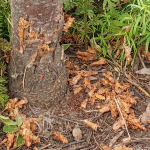
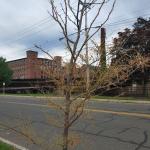 Bagworm: Thyridopteryx ephemeraeformis is a native species of moth whose larvae construct bag-like coverings over themselves with host plant leaves and twigs. This insect overwinters in the egg stage, within the bags of deceased females from last season. Eggs may hatch and young larvae are observed feeding around mid-June, or roughly between 600-900 GDD’s. Remove and destroy overwintering bags before June. In certain areas across MA in 2019, increased populations of bagworms were observed and reported. At this time, bagworm caterpillars are large (hidden within their bags made of chewed leaves and other debris) and capable of completely defoliating young trees. Bagworm caterpillars were reported feeding on honeylocust in Holyoke, MA on 7/22/20. See photos of bagworms at the base of a defoliated tree, as reported by Sarah Greenleaf, MA DCR Urban Forester. More information can be found here: https://ag.umass.edu/landscape/fact-sheets/bagworm
Bagworm: Thyridopteryx ephemeraeformis is a native species of moth whose larvae construct bag-like coverings over themselves with host plant leaves and twigs. This insect overwinters in the egg stage, within the bags of deceased females from last season. Eggs may hatch and young larvae are observed feeding around mid-June, or roughly between 600-900 GDD’s. Remove and destroy overwintering bags before June. In certain areas across MA in 2019, increased populations of bagworms were observed and reported. At this time, bagworm caterpillars are large (hidden within their bags made of chewed leaves and other debris) and capable of completely defoliating young trees. Bagworm caterpillars were reported feeding on honeylocust in Holyoke, MA on 7/22/20. See photos of bagworms at the base of a defoliated tree, as reported by Sarah Greenleaf, MA DCR Urban Forester. More information can be found here: https://ag.umass.edu/landscape/fact-sheets/bagworm
- Dogwood Borer: Synanthedon scitula is a species of clearwing moth whose larvae bore not only into dogwood (Cornus), but hosts also include flowering cherry, chestnut, apple, mountain ash, hickory, pecan, willow, birch, bayberry, oak, hazel, myrtle, and others. Kousa dogwood appear to be resistant to this species. Signs include the sloughing of loose bark, brown frass, particularly near bark cracks and wounds, dead branches, and adventitious growth. The timing of adult emergence can be expected when dogwood flower petals are dropping and weigela begins to bloom. Adult moth flights continue from then until September. Emergence in some hosts (ex. apple) appears to be delayed, but this differs depending upon the location in this insect’s range. Eggs are laid singly, or in small groups, on smooth and rough bark. Female moths preferentially lay eggs near wounded bark. After hatch, larvae wander until they find a suitable entrance point into the bark. This includes wounds, scars, or branch crotches. This insect may also be found in twig galls caused by other insects or fungi. Larvae feed on phloem and cambium. Fully grown larvae are white with a light brown head and approx. ½ inch long. Pheromone traps and lures are useful for determining the timing of adult moth emergence and subsequent management.
- Dogwood Sawfly: Macremphytus tarsatus larvae are commonly seen feeding on dogwoods, especially gray dogwood (Cornus racemosa). One generation occurs per year. The larvae of the dogwood sawfly overwinter in decaying wood and occasionally (rarely) compromised structural timber. An overwintering “cell” is created in this soft wood. Pupation occurs in the springtime and adults can take a lengthy time to emerge, roughly from late May through July. 100+ eggs are laid in groups on the underside of leaves. Eggs hatch and the larvae feed gregariously, initially skeletonizing the leaves. As the caterpillars grow in size, they are capable of eating the entire leaf, leaving only midveins behind. Larval appearance varies greatly throughout instars. Early instars are translucent and yellow, but as the caterpillars grow, they develop black spots (over the yellow) and become covered in a white powder-like material. Larvae and their shed skins may resemble bird droppings. Full-grown larvae begin to wander in search of a suitable overwintering location. Rotting wood lying on the ground is preferred for this. Sawfly caterpillars can be collected from plants and dropped into a can of soapy water.
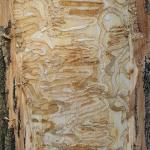
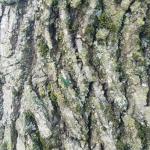
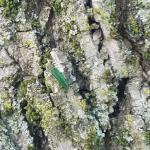 Emerald Ash Borer: (Agrilus planipennis, EAB) As of July 27, 2020, the Massachusetts Department of Conservation and Recreation has confirmed a total of at least 127 communities in Massachusetts that have known populations of emerald ash borer. An updated map of these locations across the state may be found here: https://ag.umass.edu/fact-sheets/emerald-ash-borer .
Emerald Ash Borer: (Agrilus planipennis, EAB) As of July 27, 2020, the Massachusetts Department of Conservation and Recreation has confirmed a total of at least 127 communities in Massachusetts that have known populations of emerald ash borer. An updated map of these locations across the state may be found here: https://ag.umass.edu/fact-sheets/emerald-ash-borer .
This wood-boring beetle readily attacks ash (Fraxinus spp.) including white, green, and black ash and has also been found developing in white fringe tree (Chionanthus virginicus) and has been reported in cultivated olive (Olea europaea). Adult insects of this species will not be present at this time of year. Signs of an EAB infested tree may include (at this time) D-shaped exit holes in the bark (from adult emergence in previous years), “blonding” or lighter coloration of the ash bark from woodpecker feeding (chipping away of the bark as they search for larvae beneath), and serpentine galleries visible through splits in the bark, from larval feeding beneath. Positive identification of an EAB-infested tree may not be possible with these signs individually on their own.
For further information about this insect, please visit: https://ag.umass.edu/fact-sheets/emerald-ash-borer . If you believe you have located EAB-infested ash trees, particularly in an area of Massachusetts not identified on the map provided, please report here: http://massnrc.org/pests/pestreports.htm .
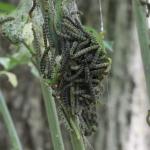 Euonymus Caterpillar: Yponomeuta cagnagella is of European origin and widespread in distribution throughout Europe. It was first reported in North America in Ontario in 1967. The euonymus caterpillars (larvae) feed in groups and envelop the foliage of the host plant in webs as they feed. Hosts include: Euonymus europaeus (tree form), E. kiautschovicus, E. alatus, and E. japonicus. Mature caterpillars are just under an inch in length, creamy yellow-gray in color with black spots and a black head capsule. By late June, these larvae pupate in white, oval-shaped cocoons which are typically oriented together vertically either on host plants or non-hosts in the area. Cocoons can be found in cracks and crevices, or webbed together leaves. The adult moth emerges in late June in most locations. The adult female secretes a gummy substance over her eggs which will harden, making them even more difficult to see. Eggs hatch by mid-August, at which time the tiny larvae prepare to overwinter beneath their eggshell-like covering. These larvae are inactive until the following year, when caterpillars group together to feed on newly emerging leaves, creating a mess of webs as they feed. There is one generation per year. Plants may be partially or entirely defoliated. Management of young, actively feeding caterpillars with Bacillus thuringiensis is possible if deemed necessary, however many species of Euonymus are considered invasive themselves.
Euonymus Caterpillar: Yponomeuta cagnagella is of European origin and widespread in distribution throughout Europe. It was first reported in North America in Ontario in 1967. The euonymus caterpillars (larvae) feed in groups and envelop the foliage of the host plant in webs as they feed. Hosts include: Euonymus europaeus (tree form), E. kiautschovicus, E. alatus, and E. japonicus. Mature caterpillars are just under an inch in length, creamy yellow-gray in color with black spots and a black head capsule. By late June, these larvae pupate in white, oval-shaped cocoons which are typically oriented together vertically either on host plants or non-hosts in the area. Cocoons can be found in cracks and crevices, or webbed together leaves. The adult moth emerges in late June in most locations. The adult female secretes a gummy substance over her eggs which will harden, making them even more difficult to see. Eggs hatch by mid-August, at which time the tiny larvae prepare to overwinter beneath their eggshell-like covering. These larvae are inactive until the following year, when caterpillars group together to feed on newly emerging leaves, creating a mess of webs as they feed. There is one generation per year. Plants may be partially or entirely defoliated. Management of young, actively feeding caterpillars with Bacillus thuringiensis is possible if deemed necessary, however many species of Euonymus are considered invasive themselves.
Want to see euonymus caterpillars in action?! I bet you’ve never seen so many of these caterpillars in one place! Check out Episode 3 of InsectXaminer: https://ag.umass.edu/landscape/education-events/insectxaminer
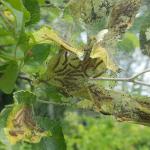
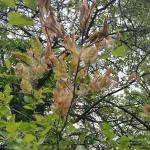 Fall Webworm: Hyphantria cunea is native to North America and Mexico. It is now considered a world-wide pest, as it has spread throughout much of Europe and Asia. (For example, it was introduced accidentally into Hungary from North America in the 1940’s.) Hosts include nearly all shade, fruit, and ornamental trees except conifers. In the USA, at least 88 species of trees are hosts for these insects, while in Europe at least 230 species are impacted. In the past history of this pest, it was once thought that the fall webworm was a two-species complex. It is now thought that H. cunea has two color morphs – one black headed and one red headed. These two color forms differ not only in the coloration of the caterpillars and the adults, but also in their behaviors. Caterpillars may go through at least 11 molts, each stage occurring within a silken web they produce over the host. When alarmed, all caterpillars in the group will move in unison in jerking motions that may be a mechanism for self-defense. Depending upon the location and climate, 1-4 generations of fall webworm can occur per year. Fall webworm adult moths lay eggs on the underside of the leaves of host plants in the spring. These eggs hatch in late June or early July depending on climate. Fall webworm caterpillars were observed feeding on foliage coated in webbing on 7/8/2020 and 7/21/2020 in Chesterfield, MA. Branches fed upon by this insect have web-coated leaves that have now turned brown. Young larvae feed together in groups on the undersides of leaves, first skeletonizing the leaf and then enveloping other leaves and eventually entire branches within their webs. Webs are typically found on the terminal ends of branches. All caterpillar activity occurs within this tent, which becomes filled with leaf fragments, cast skins, and frass. Fully grown larvae then wander from the webs and pupate in protected areas such as the leaf litter where they will remain for the winter. Adult fall webworm moths emerge the following spring/early summer to start the cycle over again. 50+ species of parasites and 36+ species of predators are known to attack fall webworm in North America. Fall webworms typically do not cause extensive damage to their hosts. Nests may be an aesthetic issue for some. If in reach, small fall webworm webs may be pruned out of trees and shrubs and destroyed. Do not set fire to H. cunea webs when they are still attached to the host plant.
Fall Webworm: Hyphantria cunea is native to North America and Mexico. It is now considered a world-wide pest, as it has spread throughout much of Europe and Asia. (For example, it was introduced accidentally into Hungary from North America in the 1940’s.) Hosts include nearly all shade, fruit, and ornamental trees except conifers. In the USA, at least 88 species of trees are hosts for these insects, while in Europe at least 230 species are impacted. In the past history of this pest, it was once thought that the fall webworm was a two-species complex. It is now thought that H. cunea has two color morphs – one black headed and one red headed. These two color forms differ not only in the coloration of the caterpillars and the adults, but also in their behaviors. Caterpillars may go through at least 11 molts, each stage occurring within a silken web they produce over the host. When alarmed, all caterpillars in the group will move in unison in jerking motions that may be a mechanism for self-defense. Depending upon the location and climate, 1-4 generations of fall webworm can occur per year. Fall webworm adult moths lay eggs on the underside of the leaves of host plants in the spring. These eggs hatch in late June or early July depending on climate. Fall webworm caterpillars were observed feeding on foliage coated in webbing on 7/8/2020 and 7/21/2020 in Chesterfield, MA. Branches fed upon by this insect have web-coated leaves that have now turned brown. Young larvae feed together in groups on the undersides of leaves, first skeletonizing the leaf and then enveloping other leaves and eventually entire branches within their webs. Webs are typically found on the terminal ends of branches. All caterpillar activity occurs within this tent, which becomes filled with leaf fragments, cast skins, and frass. Fully grown larvae then wander from the webs and pupate in protected areas such as the leaf litter where they will remain for the winter. Adult fall webworm moths emerge the following spring/early summer to start the cycle over again. 50+ species of parasites and 36+ species of predators are known to attack fall webworm in North America. Fall webworms typically do not cause extensive damage to their hosts. Nests may be an aesthetic issue for some. If in reach, small fall webworm webs may be pruned out of trees and shrubs and destroyed. Do not set fire to H. cunea webs when they are still attached to the host plant.
- Lacebugs: Stephanitis spp. lacebugs such as S. pyriodes can cause severe injury to azalea foliage. S. rhododendri can be common on rhododendron and mountain laurel. S. takeyai has been found developing on Japanese andromeda, leucothoe, styrax, and willow. Stephanitis spp.lace bug activity should be monitored through September. Before populations become too large, treat with a summer rate horticultural oil spray as needed. Be sure to target the undersides of the foliage in order to get proper coverage of the insects. Certain azalea and andromeda cultivars may be less preferred by lace bugs.
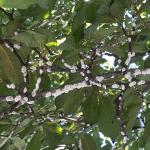
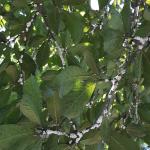 Magnolia and Tuliptree Scales: The soft scale insects known as the Magnolia scale (Neolecanium cornuparvum) and the tuliptree scale (Toumeyella liriodendri) can be difficult to differentiate in the field, depending upon the host they are found on. (On Magnolia, it is very difficult to distinguish between the two species of soft scale.) As two native scale insects in North America, the Magnolia and tuliptree scales are hosts themselves for natural enemies that can impact their populations. Solitary parasitoid larvae have been collected from Magnolia scales and have been identified as a syrphid fly species, Ocyptamus costatus. The natural enemies of the tuliptree scale have been studied to a greater degree and include certain lady beetle species [Hyperaspis signata, Adalia (formerly Hyperaspis) bipunctata, and Chilocorus stigma] which feed on nymphal scales, a number of parasitic wasps, and even an insect feeding moth caterpillar (Laetilia coccidivora). This particular moth species, also referred to as a type of snout moth, will consume the tuliptree scale underneath the protection of a silken web it spins over them! (The specific epithet coccidivora can be translated as “ones that eat soft scales” or Coccidae.) Unfortunately, in a landscape setting, it often seems that although these natural enemies may be common within the scale populations, they are seldom able to reduce the scale insect numbers below damaging levels. That being said, our management options should still seek to preserve these natural enemies.
Magnolia and Tuliptree Scales: The soft scale insects known as the Magnolia scale (Neolecanium cornuparvum) and the tuliptree scale (Toumeyella liriodendri) can be difficult to differentiate in the field, depending upon the host they are found on. (On Magnolia, it is very difficult to distinguish between the two species of soft scale.) As two native scale insects in North America, the Magnolia and tuliptree scales are hosts themselves for natural enemies that can impact their populations. Solitary parasitoid larvae have been collected from Magnolia scales and have been identified as a syrphid fly species, Ocyptamus costatus. The natural enemies of the tuliptree scale have been studied to a greater degree and include certain lady beetle species [Hyperaspis signata, Adalia (formerly Hyperaspis) bipunctata, and Chilocorus stigma] which feed on nymphal scales, a number of parasitic wasps, and even an insect feeding moth caterpillar (Laetilia coccidivora). This particular moth species, also referred to as a type of snout moth, will consume the tuliptree scale underneath the protection of a silken web it spins over them! (The specific epithet coccidivora can be translated as “ones that eat soft scales” or Coccidae.) Unfortunately, in a landscape setting, it often seems that although these natural enemies may be common within the scale populations, they are seldom able to reduce the scale insect numbers below damaging levels. That being said, our management options should still seek to preserve these natural enemies.
The Magnolia scale is distributed throughout the eastern United States. The tuliptree scale is found east of the Mississippi River from Michigan to Alabama and from New York and Connecticut to Florida. It is also reported to be found in ornamental tuliptrees and Magnolias in California and could be found wherever these trees are grown. Magnolia scale host plants include: Magnolia stellata (star Magnolia), M. acuminata (cucumber Magnolia), M. lilliflora ‘Nigra’ (lily Magnolia; formerly M. quinquepeta), and M. soulangeana (Chinese Magnolia). Other species may be hosts for this scale, but attacked to a lesser degree. M. grandiflora (southern Magnolia) may be such an example. Tuliptree scale host plants include: Liriodendron tulipifera (tuliptree or yellow poplar), Magnolia stellata (star Magnolia), and M. soulangeana (Chinese Magnolia). This insect has also been recorded on M. grandiflora (southern Magnolia) and Tilia spp. (linden). The tuliptree scale has also, to a lesser extent, been reported on other ornamental trees and shrubs.
Mature individuals settle on a location on branches and twigs, then insert piercing-sucking mouthparts to feed. The insects feed on plant fluids and excrete large amounts of a sugary substance known as honeydew. Sooty mold, often black in color, will then grow on the honeydew that has coated branches and leaves. Repeated, heavy infestations can result in branch dieback and at times, death of the plant. Honeydew may also be very attractive to ants, wasps, and hornets. The life cycle of both of these species is similar and may have similar timing during the year, however subtle differences exist. The life cycle of the Magnolia scale is as follows: This scale overwinters as a young nymph (immature stage) which is elliptical in shape, mostly a dark-slate gray, except for a median ridge that is red/brown in color. These overwintering nymphs may be found on the undersides of 1st and 2nd year old twigs. The first molt (shedding of the exoskeleton to allow growth) can occur by late April or May in parts of this insect’s range and the second molt will occur in early June. At that time, the immature scales have turned a deep purple color. Stems of the host plant may appear purple in color and thickened – but this is a coating of nymphal Magnolia scales, not the stem itself. Eventually, these immature scales secrete a white layer of wax over their bodies, looking as if they have been rolled in powdered sugar. By August, the adult female scale is fully developed, elliptical and convex in shape and ranging from a pinkish-orange to a dark brown color. Adult females may also be covered in a white, waxy coating. By that time, the females produce nymphs (living young; eggs are not “laid”) that wander the host before settling on the newest twigs to overwinter. In the Northeastern United States, this scale insect has a single generation per year.
The lifecycle of the tuliptree scale is as follows: The mature female tuliptree scale is hemispherical in shape. The color of the mature female varies in this species as well - a grayish-green to pink-orange insect mottled with black. Adult males emerge sometime in June and mate with the females. Like the Magnolia scale, eggs develop within the body of the female tuliptree scale, leading to the “live birth” of immatures (crawlers) in late August and September. In the Northeast, one generation of tuliptree scales occurs per year. (However, in the southern-most portions of its range, this insect has been found in all stages of development during the winter, suggesting multiple generations per year.) A single female tuliptree scale may produce 3,000+ crawlers in one season. These crawlers are tiny (approximately the size of the head of a pin) and settle on host plant twigs in September. Past studies have shown that in addition to moving on their own with fully functional legs, the crawlers can be blown to new hosts on the wind, up to 100 feet away. (Being wind-blown to a new host, however, is a haphazard method of travel through which some less than 20% of these crawlers successfully make contact with a host plant, and fewer still attach to a suitable site on the plant.) The immature, crawler stage molts once prior to overwintering.
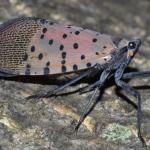 Spotted Lanternfly: (Lycorma delicatula, SLF) is not known to occur in Massachusetts landscapes (no established populations are known in MA at this time). However, due to the great ability of this insect to hitchhike using human-aided movement, it is important that we remain vigilant in Massachusetts and report any suspicious findings. Spotted lanternfly reports can be sent here:https://massnrc.org/pests/slfreport.aspx
Spotted Lanternfly: (Lycorma delicatula, SLF) is not known to occur in Massachusetts landscapes (no established populations are known in MA at this time). However, due to the great ability of this insect to hitchhike using human-aided movement, it is important that we remain vigilant in Massachusetts and report any suspicious findings. Spotted lanternfly reports can be sent here:https://massnrc.org/pests/slfreport.aspx
For a map of known, established populations of SLF as well as detections outside of these areas where individual finds of spotted lanternfly have occurred (but no infestations are present), visit: https://nysipm.cornell.edu/environment/invasive-species-exotic-pests/spotted-lanternfly/ This map depicts an individual find of spotted lanternfly at a private residence in Boston, MA that was reported by the MA Department of Agricultural Resources on February 21, 2019. More information about this detection in Boston, where no established infestation was found, is provided here: https://www.mass.gov/news/state-agricultural-officials-urge-residents-to-check-plants-for-spotted-lanternfly
This insect is a member of the Order Hemiptera (true bugs, cicadas, hoppers, aphids, and others) and the Family Fulgoridae, also known as planthoppers. The spotted lanternfly is a non-native species first detected in the United States in Berks County, Pennsylvania and confirmed on September 22, 2014.
The spotted lanternfly is considered native to China, India, and Vietnam. It has been introduced as a non-native insect to South Korea and Japan, prior to its detection in the United States. In South Korea, it is considered invasive and a pest of grapes and peaches. The spotted lanternfly has been reported from over 70 species of plants, including the following: tree of heaven (Ailanthus altissima) (preferred host), apple (Malus spp.), plum, cherry, peach, apricot (Prunus spp.), grape (Vitis spp.), pine (Pinus spp.), pignut hickory (Carya glabra), sassafras (Sassafras albidum), serviceberry (Amelanchier spp.), slippery elm (Ulmus rubra), tulip poplar (Liriodendron tulipifera), white ash (Fraxinus americana), willow (Salix spp.), American beech (Fagus grandifolia), American linden (Tilia americana), American sycamore (Platanus occidentalis), big-toothed aspen (Populus grandidentata), black birch (Betula lenta), black cherry (Prunus serotina), black gum (Nyssa sylvatica), black walnut (Juglans nigra), dogwood (Cornus spp.), Japanese snowbell (Styrax japonicus), maple (Acer spp.), oak (Quercus spp.), and paper birch (Betula papyrifera).
The adults and immatures of this species damage host plants by feeding on sap from stems, leaves, and the trunks of trees. In the springtime in Pennsylvania (late April - mid-May) nymphs (immatures) are found on smaller plants and vines and new growth of trees and shrubs. Third and fourth instar nymphs migrate to the tree of heaven and are observed feeding on trunks and branches. Trees may be found with sap weeping from the wounds caused by the insect’s feeding. The sugary secretions (excrement) created by this insect may coat the host plant, later leading to the growth of sooty mold. Insects such as wasps, hornets, bees, and ants may also be attracted to the sugary waste created by the lanternflies, or sap weeping from open wounds in the host plant. Host plants have been described as giving off a fermented odor when this insect is present.
Adults are present by the middle of July in Pennsylvania and begin laying eggs by late September and continue laying eggs through late November and even early December in that state. Adults may be found on the trunks of trees such as the tree of heaven or other host plants growing in close proximity to them. Egg masses of this insect are gray in color and look similar in some ways to gypsy moth egg masses.
Host plants, bricks, stone, lawn furniture, recreational vehicles, and other smooth surfaces can be inspected for egg masses. Egg masses laid on outdoor residential items such as those listed above may pose the greatest threat for spreading this insect via human aided movement.
For more information about the spotted lanternfly, visit this fact sheet: https://ag.umass.edu/landscape/fact-sheets/spotted-lanternfly .
- Tuliptree Aphid: Illinoia liriodendri is a species of aphid associated with the tuliptree, wherever it is grown. Depending upon local temperatures, these aphids may be present from mid-June through early fall. Large populations can develop by late summer. Some leaves, especially those in the outer canopy, may turn brown or yellow and drop from infested trees prematurely. The most significant impact these aphids can have is typically the resulting honeydew, or sugary excrement, which may be present in excessive amounts and coat leaves and branches, leading to sooty mold growth. This honeydew may also make a mess of anything beneath the tree. Wingless adults are approximately 1/8 inch in length, oval, and can range in color from pale green to yellow. There are several generations per year. This is a native insect. Management is typically not necessary, as this insect does not significantly impact the overall health of its host. Tuliptree aphids also have plenty of natural enemies, such as ladybeetles and parasites.
- Twolined Chestnut Borer: Agrilus bilineatus is a native jewel beetle (also known as a flatheaded borer) in the Family Buprestidae. This insect is also in the same genus as the invasive emerald ash borer. The twolined chestnut borer is native to Massachusetts, much of New England, and the eastern United States. This species has one generation per year and adults are typically active from April – August, depending upon location and temperature. Adults will conduct some maturation feeding on oak prior to mating. Females will lay clusters of tiny eggs in the cracks and crevices of bark. Larvae hatch from the eggs in 1-2 weeks and burrow through the bark into the cambium, where they feed in a similar manner to the emerald ash borer, creating meandering galleries as they feed. (The galleries of the twolined chestnut borer can be straight in very stressed trees.) Larvae typically mature by August – October and burrow to the outer bark where they create a chamber in which they overwinter. Pupation occurs the following spring and adults emerge through D-shaped exit holes that are approximately 1/5 inch wide. In the northern extent of this insect’s range, they can take 2 years to complete their life cycle. Larvae of this insect have been recorded from eastern white oak, common post oak, burr oak, scarlet oak, northern red oak, and eastern black oak. Adults have been recorded on fir and pin oak. These insects are attracted to stressed host plants and typically become a secondary factor in the decline of the tree.
- Two-Spotted Spider Mite: Tetranychus urticae is a “warm-season” mite that loves hot and dry weather, which may favor the quick reproduction and build-up of this pest. Management should seek to preserve beneficial predatory mites. Monitor susceptible hosts (elm, maple, redbud, ash, black locust, tuliptree, and many deciduous shrubs) for increasing numbers of these mites until mid-August. Mites will be found on the undersides of leaves and cause stippling of the foliage.
Concerned that you may have found an invasive insect or suspicious damage caused by one? Need to report a pest sighting? If so, please visit the Massachusetts Introduced Pests Outreach Project: http://massnrc.org/pests/pestreports.htm .
A note about Tick Awareness: deer ticks (Ixodes scapularis), the American dog tick (Dermacentor variabilis), and the lone star tick (Amblyomma americanum) are all found throughout Massachusetts. Each can carry their own complement of diseases. Anyone working in tick habitats (wood-line areas, forested areas, and landscaped areas with ground cover) should check themselves regularly for ticks while practicing preventative measures. Have a tick and need it tested? Visit the web page of the UMass Laboratory of Medical Zoology (https://www.tickreport.com/ ) and click on the blue Order a TickReport button for more information.
Reported by Tawny Simisky, Extension Entomologist, UMass Extension Landscape, Nursery, & Urban Forestry Program
Weeds
Summer annual grass and broadleaf weeds are increasingly more apparent in mulched landscape beds as the recent hot weather has allowed them to get VERY large. Some weeds have become sizable and spraying them will result in unsightly dead vegetation, so hand weeding may be necessary. However, spot spraying with a non-selective herbicide is usually a better strategy than hand-weeding because it does not break the mulch barrier unless the plant is clipped below the stem base, allowing new weed seeds to germinate. Determination on a site-by-site basis will be needed to select the best strategy. Inspect the mulch layer to ensure that it is thick enough to control future weed problems.
Many landscape trees commonly produce vegetative suckers at their trunk base. Suckers are commonly seen on crabapple, flowering cherry, flowering pear, plum, linden, maple and sometimes oak. Honeylocusts commonly produce vegetative sprouts along the entire length of their trunk. If these suckers or sprouts are not controlled, the landscape will be a contender for the “shabby landscape award”. Pruning is effective but very time consuming. Another option would be to use the product ScytheTM that contains pelargonic acid to remove these vegetative suckers and sprouts when they are very small. Very small means less than one inch in length or smaller. Pelargonic acid is a contact herbicide. If ScytheTM is applied to small suckers and sprouts, the product will desiccate them and physical removal will not be required. Larger growth will first need to be physically removed, then ScytheTM can be used as a maintenance program. Products that contain glyphosate should not be used as glyphosate is a translocated herbicide and injury is possible.
New growth expansion of poison ivy continues. Poison ivy is past its flowering period and small green berries can be seen on healthy plants. Herbicide applications can be done from now through mid-September. Glyphosate or triclopyr are the best herbicides for the control of poison ivy; the site will determine which herbicide you select. Glyphosate is a non-selective herbicide, while triclopyr is a broadleaf herbicide, so it will not kill grasses.
Report by Randy Prostak, Weed Specialist, UMass Extension Landscape, Nursery and Urban Forestry Program
Landscape Practices
With all of Massachusetts in a "Moderate Drought" or "Abnormally Dry" as of 8/4 , according to the US Drought Monitor (https://droughtmonitor.unl.edu/CurrentMap/StateDroughtMonitor.aspx?MA), it is important to irrigate as efficiently as possible. The following tips will help ensure that irrigation applications are as beneficial as possible.
1. Be aware of, and follow, your local town or municipality water regulations. https://www.mass.gov/doc/water-use-restrictions-map/download
2. Don’t irrigate midday. Evaporation is greatest midday, which could mean that much of the water being applied is lost before it reaches plants! Wind also contributes to evaporation and can change irrigation spray patterns. Early morning and evening are the best times to irrigate.
3. Use drip irrigation or soaker hoses when possible. Overhead irrigation frequently results in watering non-plant surfaces and can result in water interception by plant canopies which can reduce the water that reaches the plants’ root systems.
4. Maintain your irrigation system. Check for leaks, broken spray heads, and perform an irrigation system audit to assure uniformity.
5. Use smart technology. Smart controllers can monitor soil moisture and use environmental conditions to adjust irrigation based on water being lost to evapotranspiration (evaporation and transpiration).
6. Water deeply, allowing water to soak into the ground. Irrigating slowly (via drip irrigation or a slow flow) is key to achieving infiltration vs. runoff. Newly installed plants will need more frequent irrigation until established, especially container grown plants that were produced in soilless substrates. Less frequent, deeper irrigation encourages good root growth which will help plants survive water stress.
7. Apply mulch to planting beds and in tree rings 2-4” deep. Keep mulch away from the base of plants and trees. Mulch helps reduce evaporation, insulates plant roots, and can add organic matter to the soil.
8. Raise your mower blade. Longer grass promotes deeper roots and a more drought-resistant lawn.
9. Reduce the competition for water by controlling weeds.
10. Don’t apply fertilizer under drought conditions. High fertilizer concentration can make available water unavailable to plants. Fertilization will also result in increased growth which increases the water demand.
11. Keep in mind that landscapes typically require one inch of water per week (including rainfall). Unsure of what your system or sprinkler is applying? You can use a rain gauge and see how much water is collected in a certain period of time (30 minutes for example). Use multiple rain gauges if possible to understand if you have good uniformity, or make sure the rain gauge is located in an “average area”.
Report by Mandy Bayer, Extension Assistant Professor of Sustainable Landscape Horticulture, UMass Stockbridge School of Agriculture
Additional Resources
To receive immediate notification when the next Landscape Message update is posted, join our e-mail list or follow us on Facebook and Twitter.
For a complete listing of upcoming events, see our upcoming educational events https://ag.umass.edu/landscape/upcoming-events
For commercial growers of greenhouse crops and flowers - Check out UMass Extension's Greenhouse Update website
For professional turf managers - Check out Turf Management Updates
For home gardeners and garden retailers - Check out our home lawn and garden resources. UMass Extension also has a Twitter feed that provides timely, daily gardening tips, sunrise and sunset times to home gardeners at twitter.com/UMassGardenClip
Diagnostic Services
A UMass Laboratory Diagnoses Landscape and Turf Problems - The UMass Extension Plant Diagnostic Lab is available to serve commercial landscape contractors, turf managers, arborists, nurseries and other green industry professionals. It provides woody plant and turf disease analysis, woody plant and turf insect identification, turfgrass identification, weed identification, and offers a report of pest management strategies that are research based, economically sound and environmentally appropriate for the situation. Accurate diagnosis for a turf or landscape problem can often eliminate or reduce the need for pesticide use. For sampling procedures, detailed submission instructions and a list of fees, see Plant Diagnostics Laboratory
Soil and Plant Nutrient Testing - The University of Massachusetts Soil and Plant Nutrient Testing Laboratory is located on the campus of The University of Massachusetts at Amherst. Testing services are available to all. The function of the Soil and Plant Nutrient Testing Laboratory is to provide test results and recommendations that lead to the wise and economical use of soils and soil amendments. For complete information, visit the UMass Soil and Plant Nutrient Testing Laboratory web site. Alternatively, call the lab at (413) 545-2311.
Ticks are active any time that temperatures are above freezing! Remember to take appropriate precautions when working and playing outdoors, and conduct daily tick checks. UMass tests ticks for the presence of Lyme disease and other disease pathogens. Learn more
